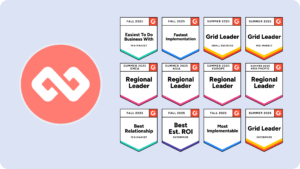Jess Benham is Mentorloop’s Head of Sales at Mentorloop. In this article, she shares her insights on the conversations she is having around the use of data to measure success and justify investment in mentoring programs.
Over the last 12 months, something radical has happened in the talent market. Attracting and keeping the right people to serve your business goals has become more challenging and much more costly. So it comes as no surprise that HR professionals are finding that offering learning and development opportunities is gaining importance.
At the same time, these same professionals are being held back by a serious lack of spending and a higher level of justification of spending by their businesses. With this scrutiny on L&D spend, your people-focused initiatives need to yield and show tangible results. But how do you get rich performance data for mentoring programs to safeguard your mentoring budget?
Let’s get to it.
Measuring Outcomes Instead of Activity
If we are going to measure the real impact of a mentoring program, first we need to understand the difference between outcome and activity.
This is something we talk about a lot at Mentorloop. This is either because we get asked about the right way to measure success or because we have people come to us who have measured their programs in a certain way before and have not found it helpful or effective.
With a focus on the bottom line and productivity, we have seen that more People & Culture teams are finding value in measuring the real outcomes of mentoring rather than the time spent mentoring or activities like log-ins. And when you are focusing on the what rather than the how you are missing the point of why you were running a program in the first place.
We understand why many program coordinators have previously measured their programs in activity. It’s because most tools only have the capability to measure log-ins, messages sent, or meetings booked. It’s very hard to measure outcomes, especially when this can look so different for individual programs and organizations. So how do we bridge that gap?
Mentoring Program Data
You can measure anything these days. However, there are a few key data points that your mentoring software should have to enable you to conduct meaningful reporting.
Our approach to data here at Mentorloop is to make sure we’re giving you rich, real-time data on the quality of the mentoring relationships so you can easily use them to support your program’s goals.
At Mentorloop, we stay away from measuring a mentoring program’s success through time spent or activity logged. Instead, we focus on the quality of the mentoring happening. Instead of tracking how many hours they spend talking and being unsure of whether those hours are productive, we tackle questions around their Sentiment about their mentoring journey. Are your participants happy with their match? How are they feeling about their mentoring relationship?
Of course, that doesn’t mean we don’t give you any quantitative measurements. We just make sure that the metrics you access have value! By measuring things like the match rate within the program, the goals your participants set and tick off, and the general Sentiment rating among your cohort you get a more holistic picture of the real success of your program
What this means is that the quantitative data you get gives you deeper context that complements your qualitative data. Instead of just informing you of how many hours your cohort has spent mentoring, you get data on whether your cohort is actually making good use of the time they spend with their mentoring partners.
Demographics
These are the basics. Your software should tell you who is in your program, where are they from, etc. This data helps with determining whether you’re targeting the right people based on your program goals. It can also tell you where you may need to improve marketing and recruitment.
Participant Insights
You need to know why your participants joined your program. What are their goals? What skills are they wanting to learn? These are important not just for things like knowing to recruit more mentors that can help with certain high-demand skills or knowledge, but it can also inform your other L&D initiatives.
At Mentorloop. we have supported programs all over the world by enabling program coordinators to identify what their people’s goals truly are and how well they’re progressing towards them. This helps to understand not just how productive they are being but also opens a rare window into their people’s real aspirations and goals.
Participant Progress
How are your participants tracking? Are they stuck at a certain stage? Have they set goals yet? These are things you need to know so you can gauge whether or not your participants are actually getting something out of their mentoring pairings.
From what we’ve seen, this is where a lot of other mentoring software fails. Not Mentorloop. We make sure you always have visibility around what stage in the journey your participants are at and whether they’re stuck or having trouble.
Learn more about how Mentorloop ensures you’re always on top of your program’s momentum
Sentiment
Some things are better in words. And it’s so important that your data comes with context. Yes, it’s good to hear that 97% of your participants are “very satisfied” with the program, but the value of the stories behind that satisfaction cannot be understated. It also gives you insight into what’s truly working in your program and how it’s impacting the lives of those in it.

This kind of qualitative data is what brings to life the importance and impact that your program has on your organization. It’s also the secret sauce to your recruitment efforts, securing buy-in and support from leadership, and even securing more budget or sponsorship.
Individual Program Goals
We’re mentoring experts here at Mentorloop, but definitely not the experts at what your organization needs. That’s you, of course! Besides, even within the same organization, every program has slightly different goals.
So, what to do? First, make sure that at the beginning of your program, you are collecting some baseline data points. This gives you something to compare new data to. For example, if your program’s goal is retention, make sure you’re collecting attrition data as well as collating the most common reasons for leaving via exit interviews. These then get measured against the same data 12 months later.
Where your mentoring software comes in is in measuring the data points that can support this. For example, if one of your program goals is to increase the amount of women participating in leadership development activities across the organization, your mentoring software should tell you:
- Whether you have enough women participating in the program whether as mentors or mentees
- How many of those women have signed up as mentors or mentees
- How many senior leaders have signed up to the program
- How many of these senior leaders are currently mentoring women
Learn more about common mentoring program goals and how to measure them.
Efficiency
While this isn’t necessarily data about your program, we have to be realistic. In an ideal world, we would all spare no expense and effort to make sure our people are getting the best development opportunities possible. However, we don’t have that luxury. No matter how effective an initiative is, if it’s not possible to run it efficiently, then it’s not sustainable.
So, how much time would you or someone in your team have spent running a mentoring program manually vs with mentoring software like Mentorloop? How much would this have cost you, not just in wages, but in the work that wasn’t done to make room for manual program coordination?
Using mentoring software saves you an incredible amount of time, not just in the matching stage but also in the day-to-day admin.

Having worked with hundreds of customers all over the world one thing is clear, time = money and my customers are especially appreciative of the time that Mentorloop saves them while generating real-time insights with laser accuracy.
As an example, when I started working with a particular customer, they were doing their best when it came to reporting on their program but, like most people, they didn’t have the time to dedicate the time and effort required to generate reports. The problem is that senior stakeholders loved to see them and those reports formed the backbone of driving stakeholder engagement. Utilizing Mentorloop’s one-click report generator, they were able to have the best of both worlds – dedicate their time and effort to running a fantastic mentoring program while making their stakeholders happy and keeping that leadership buy-in.
We’ve created a tool for you to be able to approximate the value of running your program manually vs with mentoring software like Mentorloop. Check it out:
Do More With Your Data On Mentorloop
So now you have the right kind of data. Great! Well, now you have to know how to use it effectively. That’s where filtering and export options come in.
Focus Your Reporting With Filters and Exports
Mentorloop allows you to easily filter and segment your data in many ways so you always have the flexibility to measure and report as broadly or specifically as you’d like. This way, you’re not just sharing a wall of metrics. Instead, you’re able to deliver focused, relevant insights that speak directly to your goals.
You can filter your reports by:
- Date range – Perfect for tracking specific cohorts or quarterly outcomes
- Participant type – Focus in on mentors, mentees, or those in dual roles
- Department or team – Highlight engagement across business areas
- Custom fields – Drill into any unique segment you’ve defined
Whether you’re reporting to leadership, tracking impact in a specific group, or keeping a pulse on engagement over time, these filters help you tell a clearer story with meaningful data.
This also allows you to provide segment-specific support, giving your mentors and mentees the benefit of bespoke mentoring guidance without you having to spend the time needed for one-on-one support.
Making Your Data Actionable
Having the data isn’t enough – you also need to be able to use it to take meaningful action to improve your program or address any issues. This is why Mentorloop goes the extra mile when it comes to your mentoring program data. We make sure we put your data into context by giving you benchmarks, as well as Insights that show you how to use this data to manage and improve your program – all within easy reach on your Program Dashboard.
Turning Feedback Into Tools
We have found that our customers regularly use their Sentiment data and highlights to recruit mentors and mentees for their program. They use Mentorloop to identify their mentoring champions and leverage their voices and influence to communicate the benefits of mentorship to the organization. These become key recruitment assets for them because not only are they effective, but they’re also free!




